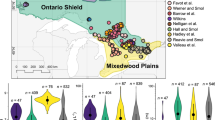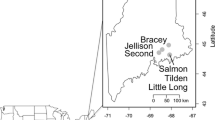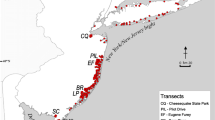Abstract
Atmospheric deposition of reactive nitrogen (Nr) has enriched oligotrophic lakes with nitrogen (N) in many regions of the world and elicited dramatic changes in diatom community structure. The lakewater concentrations of nitrate that cause these community changes remain unclear, raising interest in the development of diatom-based transfer functions to infer nitrate. We developed a diatom calibration set using surface sediment samples from 46 high-elevation lakes across the Rocky Mountains of the western US, a region spanning an N deposition gradient from very low to moderate levels (<1 to 3.2 kg Nr ha−1 year−1 in wet deposition). Out of the fourteen measured environmental variables for these 46 lakes, ordination analysis identified that nitrate, specific conductance, total phosphorus, and hypolimnetic water temperature were related to diatom distributions. A transfer function was developed for nitrate and applied to a sedimentary diatom profile from Heart Lake in the central Rockies. The model coefficient of determination (bootstrapping validation) of 0.61 suggested potential for diatom-inferred reconstructions of lakewater nitrate concentrations over time, but a comparison of observed versus diatom-inferred nitrate values revealed the poor performance of this model at low nitrate concentrations. Resource physiology experiments revealed that nitrogen requirements of two key taxa were opposite to nitrate optima defined in the transfer function. Our data set reveals two underlying ecological constraints that impede the development of nitrate transfer functions in oligotrophic lakes: (1) even in lakes with nitrate concentrations below quantification (<1 μg L−1), diatom assemblages were already dominated by species indicative of moderate N enrichment; (2) N-limited oligotrophic lakes switch to P limitation after receiving only modest inputs of reactive N, shifting the controls on diatom species changes along the length of the nitrate gradient. These constraints suggest that quantitative inferences of nitrate from diatom assemblages will likely require experimental approaches.






Similar content being viewed by others
References
American Public Health Association (2000) Standard methods for the examination of water and wastewater, 20th edition. American Public Health Association, Washington, DC
Baron JS (2006) Hindcasting nitrogen deposition to determine an ecological critical load. Ecol Appl 16:433–439
Baron JS, Rueth HM, Wolfe AM, Nydick KR, Allstott EJ, Minear JR, Moraska B (2000) Ecosystem responses to nitrogen deposition in the Colorado Front Range. Ecosystems 3:352–368
Bergström AK (2010) The use of TN:TP and DIN:TP ratios as indicators for phytoplankton nutrient limitation in oligotrophic lakes affected by N deposition. Aquat Sci. doi:10.1007/s00027-010-0132-0
Bergström AK, Jansson M (2006) Atmospheric nitrogen deposition has caused nitrogen enrichment and eutrophication of lakes in the northern hemisphere. Glob Change Biol 12:635–643
Bergström AK, Johnsson A, Jansson M (2008) Phytoplankton responses to nitrogen and phosphorus enrichment in unproductive Swedish lakes along a gradient of atmospheric nitrogen deposition. Aquat Biol 4:55–64
Bloom AM, Moser KA, Porinchu DF, MacDonald GM (2003) Diatom-inference models for surface-water temperature and salinity developed from a 57-lake calibration set from the Sierra Nevada, California, USA. J Paleolimnol 29:235–255
Bradshaw EG, Anderson NJ, Jensen JP, Jeppesen E (2002) Phosphorus dynamis in Danish lakes and the implications for the diatom ecology and palaeoecology. Freshw Biol 47:1963–1975
Camburn KE, Charles DF (2000) Diatoms of low-alkalinity lakes in the Northeastern United States. Publication, Proc Acad Natl Sci Phila Special 18
Curtis CJ, Juggins S, Clarke G, Battarbee RW, Kernan M, Catalan J, Thompson R, Posch M (2009) Regional influence of acid deposition and climate change in European mountain lakes assessed using diatom transfer functions. Freshw Biol 54:2555–2572
Elser JJ, Andersen T, Baron JS, Bergström AK, Jansson M, Kyle M, Nydick KR, Steger L, Hessen DO (2009) Shifts in Lake N:P stoichiometry and nutrient limitation driven by atmospheric nitrogen deposition. Science 326:835–837
Elser JJ, Peace AL, Kyle M, Wojewodzic M, McCrackin ML, Andersen T, Hessen DO (2010) Atmospheric nitrogen deposition is associated with elevated phosphorus limitation of lake zooplankton. Ecol Lett 13:1256–1261
Fairchild GW, Lowe RL, Richardson WB (1985) Algal periphyton growth on nutrient-diffusing substrates: an insitu bioassay. Ecology 66:465–472
Gardner EM, McKnight DM, Lewis WM Jr, Miller MP (2008) Effects of nutrient enrichments on phytoplankton in an alpine lake, Colorado, USA. Arct Antarct Alp Res 40:55–64
Grover JP (1989) Phosphorus-dependent growth kinetics of 11 species of freshwater algae. Limnol Oceanogr 34:341–348
Krammer K, Lange-Bertalot H (1986–1991) Bacillariophyceae. In: Ettl H, Gärtner G, Gerloff J, Heynig H, Mollenhauer D (eds) Süßwasserflora von Mitteleuropa. Gustav Fischer Verlag, Stuttgart, vol 2(1–4)
Lewis WM, Wurtsbaugh WW (2008) Control of lacustrine phytoplankton by nutrients: erosion of the phosphorus paradigm. Int Rev Hydrobiol 93:446–465
Lim DSS, Douglas MSV, Smol JP (2001) Diatoms and their relationship to environmental variables from lakes and ponds on Bathurst Island, Nunavut, Canadian High Arctic. Hydrobiologia 450:215–230
Michel TJ, Saros JE, Interlandi SJ, Wolfe AP (2006) Resource requirements of four freshwater diatom taxa determined by in situ growth bioassays using natural populations from alpine lakes. Hydrobiologia 568:235–243
Morris DP, Lewis WM Jr (1988) Phytoplankton nutrient limitation in Colorado mountain lakes. Freshw Biol 20:315–327
National Atmospheric Deposition Program (2007) Nitrate we ion deposition. Accessed 16 April 2009 <http://nadpiswsillinoisedu/isopleths/maps2007/no3depgif>
Nydick KR, Lafroncois BM, Baron JS, Johnson BM (2003) Lake-specific responses to elevated atmospheric nitrogen deposition in the Colorado Rocky Mountains, U.S.A. Hydrobiologia 510:103–114
Rose KC, Williamson CE, Saros JE, Sommaruga R, Fischer JM (2009) Differences in UV transparency and thermal structure between alpine and subalpine lakes: implications for organisms. Photochem Photobiol Sci 8:1244–1256
Saros JE, Interlandi SJ, Wolfe AP, Engstrom DR (2003) Recent changes in the diatom community structure of lakes in the Beartooth Mountain Range, USA. Arct Antarct Alp Res 35:18–23
Saros JE, Michel TJ, Interlandi SJ, Wolfe AP (2005a) Resource requirements of Asterionella formosa and Fragilaria crotonensis in oligotrophic alpine lakes: implications for recent phytoplankton community reorganizations. Can J Fish Aquat Sci 62:1681–1689
Saros JE, Interlandi SJ, Doyle S, Michel TJ, Williamson CE (2005b) Are the deep chlorophyll maxima in alpine lakes primarily induces by nutrient availability, not UV avoidance? Arct Antarct Alp Res 37:557–563
Saros JE, Rose KC, Clow DW, Stephens VC, Nurse AB, Arnett HA, Stone JE, Williamson CE, Wolfe AP (2010) Melting alpine glaciers enrich high-elevation lakes with reactive nitrogen. Environ Sci Technol 44:4891–4896
Saros JE, Clow DW, Blett T, Wolfe AP (2011) Critical nitrogen deposition loads in high-elevation lakes of the western U.S. inferred from paleolimnological records. Water Air Soil Pollut 216:193–202
Siver PA (1999) Development of paleolimnological inference models for pH, total nitrogen and specific conductivity based on planktonic diatoms. J Paleolimnol 21:45–59
Soininen J (2002) Responses of epilithic diatom communities to environmental gradients in some Finnish rivers. Int Rev Hydrobiol 87:11–24
Stelzer RS, Lamberti GA (2001) Effects of N:P ratio and total nutrient concentration on stream periphyton community structure, biomass and elemental composition. Limnol Oceanogr 46:356–367
Williams MW, Tonnessen KA (2000) Critical loads for inorganic nitrogen deposition in the Colorado Front Range, USA. Ecol Appl 10:1648–1665
Wolfe AP, Baron JS, Cornett RJ (2001) Anthropogenic nitrogen deposition induces rapid ecological changes in alpine lakes of the Colorado Front Range (USA). J Paleolimnol 25:1–7
Wolfe AP, Van Gorp AC, Baron JS (2003) Recent ecological and biogeochemical changes in alpine lakes of Rocky Mountain National Park (Colorado, USA): a response to anthropogenic nitrogen deposition. Geobiology 1:153–168
Acknowledgments
We thank Kevin Rose, William Grey, Chelsea Lucas, Erin Wilcox, and Neil Winn for valuable field assistance. Steve Juggins assisted with statistical analyses. Two anonymous reviewers provided comments and feedback that substantially improved this manuscript. This project was funded by the National Park Service and the U.S. National Science Foundation (DEB-0089600 and DEB-0734277).
Author information
Authors and Affiliations
Corresponding author
Appendix
Appendix
Rights and permissions
About this article
Cite this article
Arnett, H.A., Saros, J.E. & Alisa Mast, M. A caveat regarding diatom-inferred nitrogen concentrations in oligotrophic lakes. J Paleolimnol 47, 277–291 (2012). https://doi.org/10.1007/s10933-011-9576-z
Received:
Accepted:
Published:
Issue Date:
DOI: https://doi.org/10.1007/s10933-011-9576-z




